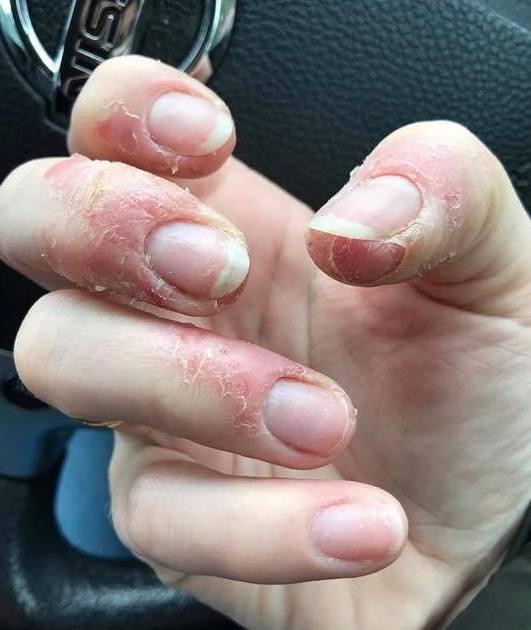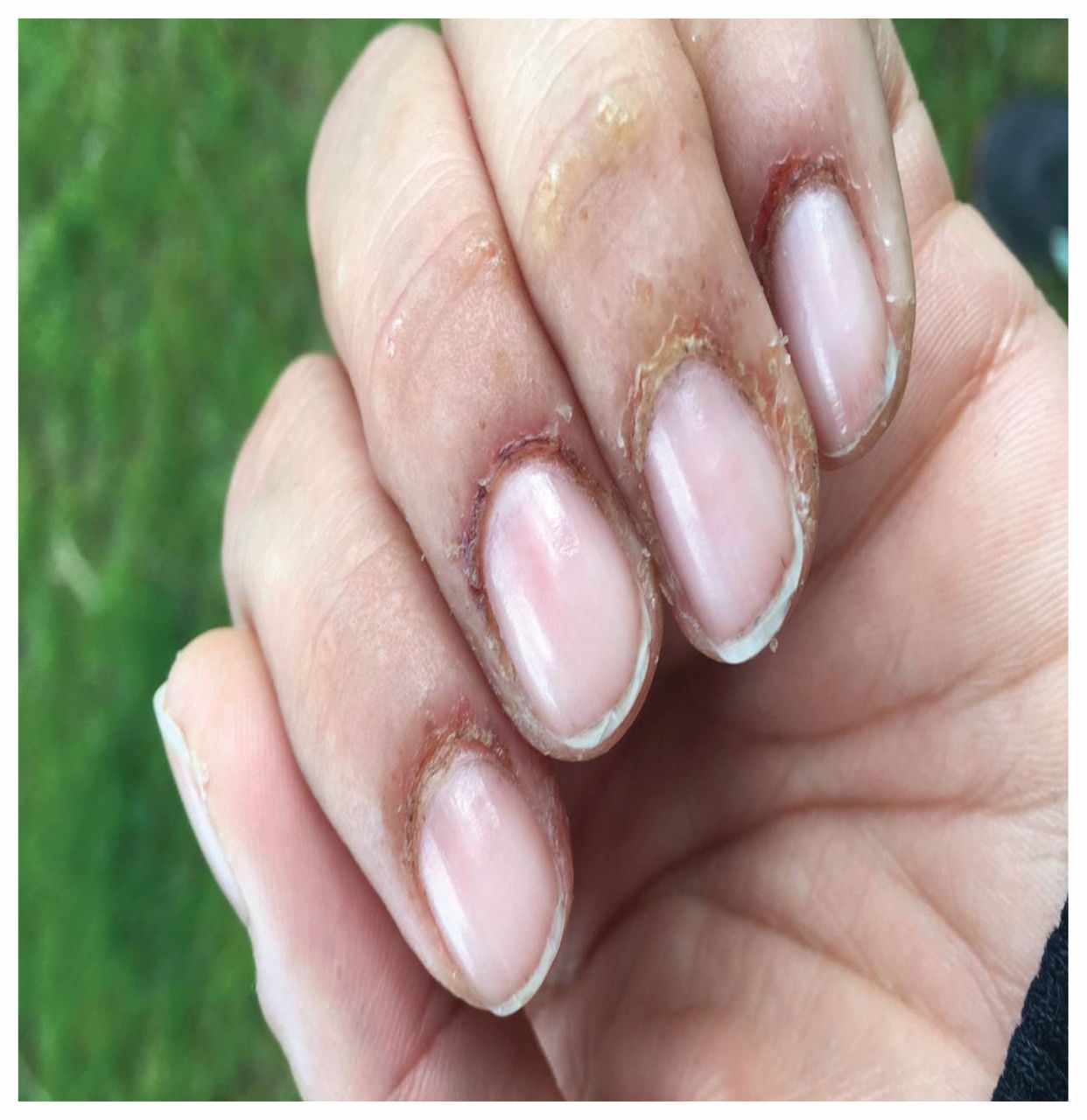Acrylic Nails & Contact Dermatitis: Risks & Solutions
Are your perfectly manicured nails potentially causing more harm than good? The seemingly harmless world of acrylic nails may be harboring hidden dangers, leading to uncomfortable skin reactions and, in some cases, career-altering consequences.
The pursuit of beauty often involves a delicate balance, and in the realm of nail enhancements, this balance can be easily disrupted. Individuals with a passion for perfectly sculpted acrylics, gel manicures, or even regular nail polish may unknowingly be exposing themselves to a range of potential allergens and irritants. These substances, often found within the very products designed to beautify, can trigger allergic or irritant contact dermatitis, an inflammatory skin condition characterized by a rash, itching, swelling, and discomfort.
The implications of these skin reactions extend beyond mere inconvenience. For nail professionals, the consequences can be particularly severe, potentially leading to the end of their careers or significant limitations in their ability to practice their craft. Similarly, for consumers, the joy of a flawless manicure can be overshadowed by the persistent discomfort and potential health risks associated with contact dermatitis.
- Celebrity Birthmarks Inspiring Beautiful Learn More
- Hamburger Factory In Poway A Review What To Expect
The primary culprits behind these skin issues are often the chemicals present in nail cosmetics, particularly (meth)acrylates. These compounds, widely used for their adhesive and hardening properties, are known sensitizers capable of triggering allergic reactions. When the skin comes into contact with these allergens, the immune system can overreact, leading to the characteristic symptoms of contact dermatitis.
The presentation of contact dermatitis can vary. While fingers may be directly affected, the rash often manifests in other areas. The eyelids, areas behind the ears, the mouth, chin, sides of the neck, and even the genitalia can become sites of inflammation. The severity of the reaction also varies, ranging from mild redness and itching to more severe blistering and peeling of the skin.
Understanding the root causes of contact dermatitis is crucial for both nail professionals and consumers. By identifying the specific allergens and irritants involved, it becomes possible to take proactive measures to minimize the risk of developing these unwanted skin reactions. For nail technicians, this may involve adjusting their practices, implementing protective measures, and selecting safer products. For consumers, it may necessitate careful product selection, awareness of personal sensitivities, and a willingness to adjust their nail care routines.
The information provided in this article should not be considered medical advice. Always consult with a qualified healthcare professional for any health concerns or before making any decisions related to your health or treatment.
| Characteristic | Details |
|---|---|
| Condition | Allergic Contact Dermatitis (ACD) from Nail Cosmetics |
| Definition | An inflammatory skin reaction caused by an allergic response to chemicals found in nail products. |
| Common Causes | (Meth)acrylates (used in acrylic nails, gel polish), Formaldehyde, Toluene, Formaldehyde resin, and other chemicals in nail cosmetics. |
| Symptoms | Itching, redness, swelling, blisters, peeling or splitting skin, nail separation. |
| Affected Areas | Fingers, eyelids, areas behind the ears, around the mouth and chin, sides of the neck, and sometimes the genitalia. |
| Exposure | Consumers (43%) and Nail Technicians (56%) |
| Treatment | Avoidance of the allergen, topical corticosteroids, emollients. Consult a dermatologist. |
| Prevention for Nail Technicians | Wearing gloves, ventilation, avoiding skin contact with uncured products, using hypoallergenic products. |
| Prevention for Consumers | Choose reputable salons, be aware of products used, inform nail tech of any allergies or sensitivities, take breaks from nail enhancements. |
| Reference | PubMed Central |
Contact dermatitis, by definition, is a rash that emerges when the skin encounters a substance to which it is allergic or that irritates it. This can happen through direct contact, and the consequences range from localized irritation to widespread inflammation. The rash may be itchy, uncomfortable, and visually displeasing, marked by redness, swelling, and sometimes blisters.
Avoiding the causative agent is the primary approach to preventing the recurrence of contact dermatitis. This might involve identifying and eliminating specific allergens or irritants from your environment or modifying your behavior to minimize exposure.
One of the most prevalent culprits behind allergic contact dermatitis (ACD) in the context of nail cosmetics is (meth)acrylates. These substances are found in a variety of products, including acrylic nails and certain types of gel polish. They are valued for their ability to harden and adhere, making them essential components of many nail enhancement systems. Prolonged contact with such products, or the chemicals used in their formulation, can lead to sensitization over time, with allergic reactions becoming more likely with repeated exposure.
It's worth noting that acrylates are also used in other products such as medical adhesives, which are used for dressings. In the medical context, sensitivity to acrylates in adhesives could lead to similar symptoms and could even impede the effectiveness of a wound's healing process. Therefore, the principle of avoiding the trigger applies across sectors.
Prolonged and intimate contact with sanitary pads can predispose individuals to acd triggered by a variety of allergens. This highlights the role of everyday products in sensitizing the skin and fostering ACD.
For professionals in the nail industry, contact dermatitis presents a serious occupational hazard. The constant handling of potentially sensitizing chemicals, coupled with the repeated exposure, can make nail technicians particularly susceptible. The condition can range from a mild nuisance to a debilitating condition, potentially affecting the ability to perform job duties. This makes preventative measures essential.
Fortunately, contact dermatitis is frequently preventable. Embracing specific precautions within a salon setting can significantly reduce the risk. These practices are not merely recommendations; they are critical safeguards that protect the well-being of both nail professionals and their clients.
One straightforward solution to prevent contact dermatitis is the consistent use of gloves. Proper gloves act as a physical barrier, preventing direct contact between the skin and potentially irritating or allergenic chemicals. This is a simple yet powerful tool in any nail salon.
The prevalence of contact dermatitis related to nail products is noteworthy. Studies indicate that a considerable percentage of affected individuals are exposed as consumers, while a slightly higher percentage experience occupational exposure. This underscores that both consumers and professionals are at risk, making a comprehensive approach to prevention and awareness essential.
The most common warning sign of contact dermatitis associated with nail products is itchy skin around the nails. However, the symptoms extend beyond the nails themselves. Blisters, splitting or peeling skin, and even nail separation can also occur, leading to both discomfort and aesthetic concerns.
Experts in the field recommend several steps to mitigate the risk of contact allergies. These include careful product selection, meticulous hygiene practices, and diligent attention to client sensitivities. Educating both nail technicians and clients on the risks involved is paramount.
The removal of gel polish can also pose a risk, especially when it involves forceful methods like ripping the polish off. This action can remove layers of the natural nail, rendering it more vulnerable to penetration by any uncured product residues. This uncured material can then seep into the nail structure and enter the bloodstream, initiating or exacerbating contact dermatitis.
Research has shed light on the intricate nature of contact dermatitis caused by nail acrylates. It is essential for industry professionals, researchers, and consumers to stay informed of these advancements.
The European Union and North America have witnessed an increase in reported cases of allergic contact dermatitis due to the use of nail cosmetics. The ongoing research helps to identify the specific allergens and develop preventive measures. These efforts are helping to safeguard both professional nail technicians and consumers.
The connection between acrylic nails and contact dermatitis revolves around allergens found within nail cosmetics. These chemicals, which include acrylates, are responsible for the beautiful finished look. When skin is exposed to these allergens, it can trigger an allergic reaction, leading to contact dermatitis.
A study in Amsterdam, Netherlands, focused on investigating the occurrence and clinical characteristics of ACD linked to nail cosmetics within a university hospital setting. This research adds to our collective understanding of how frequently and under what conditions these issues occur.
Many ingredients in nail cosmetics are capable of triggering allergic reactions. These materials can sensitize the body's immune system, causing contact dermatitis. This complexity underlines the need for strict product regulation and consumer awareness.
One case highlighted in 2017 concerned contact dermatitis caused by methacrylate, specifically found in shellac nail polish, a product developed by a prominent nail brand. Such cases serve as a reminder that the risks can be linked to certain popular products.
The nail unit can be affected by contact dermatitis through irritation or allergic reactions, with the latter accounting for 20% of nail contact dermatitis cases. This highlights the prominence of ACD in this area.
Dermatitis in the nail apparatus typically impacts the proximal nail fold (pnf) and the hyponychium. This can lead to skin alterations and abnormalities in the nail plate itself.
Experts frequently cite acrylates present in nail enhancement products or paraphenylenediamine (ppd) in hair dye as common examples of allergic contact dermatitis triggers.
Both consumers and professional nail technicians are affected, leading to occupational ACD. This emphasizes the need for understanding and preventative measures in both settings.
In allergic nail contact dermatitis, onychoscopy (examination of the nail unit) reveals specific patterns. This includes a slightly dented onycholytic margin and mild subungual hyperkeratosis, with no pitting or erythematous border. The absence of a red border surrounding the distal edge of detachment can differentiate it from nail psoriasis.
An allergic reaction to nail polish is classified as contact dermatitis and is caused by chemicals in polishes, fragrances, and creams.
The relationship between acrylic nails and contact dermatitis arises from the allergens present in nail cosmetics. These ingredients, like acrylates, can trigger allergic reactions when they touch the skin, causing contact dermatitis.
The symptoms of contact dermatitis often include redness, itching, and swelling. These symptoms should prompt one to avoid the causal agent and seek medical advice if the symptoms worsen or do not subside.
- Capricorn Cancer In Bed Compatibility Secrets Unveiled
- Celebrity Skin Bleaching A Deep Dive Into The Controversial Topic

Dermatitis NailKnowledge

Contact dermatitis caused by methacrylates in nail products CMAJ

Allergic Contact Dermatitis to Acrylate Chemicals in Artificial Nails